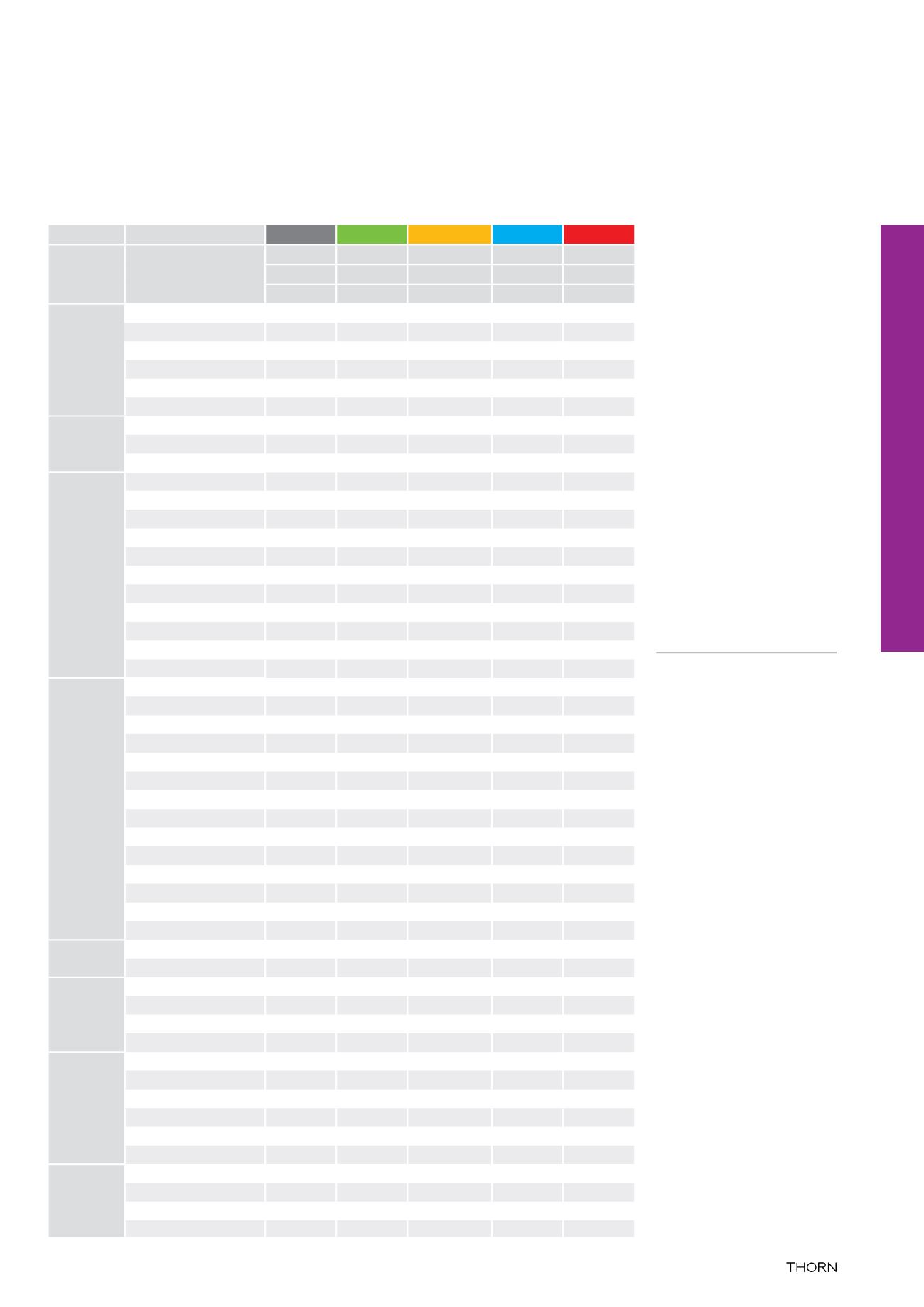

253
www.thornlighting.co.ukChemical Resistance Table
When selecting the right fitting for
an application, you will need to
consider how chemical
substances may affect the luminaire.
This may be a corrosive element in
the atmosphere or special cleaning
agents used in the location.
No materials can withstand the
effects of every chemical and it
would be difficult to display the
entire list.
However, the table is a selection of
the most common chemicals that are
used in applications where these
fittings are likely to be specified.
The information contained in the
table is valid under the following
conditions:
•The chemical substance listed in
the table is an element and not part
of a chemical compound
•The ambient temperature is 22°C
This information is provided to give
guidance about luminaire selection
assuming prolonged exposure to
potentially aggressive chemicals or
atmospheres. Occasional exposure
to low concentrations of potential
aggressors is unlikely to be harmful
to any of these luminaires. The
risk of damage to the luminaires is
dependent on the concentration
of the aggressor, the duration
and frequency of exposure and
environmental conditions. If there is
any doubt about the suitability of a
luminaire for a particular application
please enquire with details of the
chemicals which will be present and
the conditions of use.
Chemical Type Chemicals Specific
AquaForce
ImpactForce
CorrosionForce
ColdForce
HeatForce
PC body
GRP body
GRP body
GRP body
GRP body
PC diffuser
PC diffuser
PMMA diffuser
PC diffuser
PC diffuser
PC toggle
Stainless toggle Stainless toggle Stainless toggle Stainless toggle
Acids
acetic <30%
�
�
-
�
�
nitric <10%
�
�
�
�
�
sulphuric <20%
�
�
�
�
�
hydrochloric <10%
�
�
�
�
�
chromic <20%
�
�
�
�
�
phosphoric <40%
�
�
�
�
�
Salts
marine salts
�
�
�
�
�
copper sulphate
�
�
�
�
�
sodium chloride
�
�
�
�
�
Organics
(aliphatics)
Organics
(aromatics)
ethanol <30%
�
�
�
�
�
propanol<30%
�
�
�
�
�
methane
�
�
�
�
�
propane
�
�
�
�
�
formaldehyde/formalin
�
�
�
�
�
formic acid<5%
�
�
�
�
�
stearic acid soap
�
�
�
�
�
urea
�
�
�
�
�
ethylene glycol (antifreeze)
�
�
�
�
�
glucose sugar
�
�
�
�
�
glycerol/glycerine
�
�
�
�
�
Foodstuffs,
cooking
products
drinks,
beverages
milk
�
�
�
�
�
fruit juices
�
�
�
�
�
vegetable oils (cold)
�
�
�
�
�
vegetable oils (hot)
-
-
�
-
-
meats, beef, lamb, pork, game, poultry
�
�
�
�
�
fish
�
�
�
�
�
pork fat
-
-
�
-
-
cooking fats (cold)
�
�
�
�
�
cooking fats (hot)
-
-
�
-
-
alcoholic beverages beer
�
�
�
�
�
carbonated beverages, lemonade
�
�
�
�
�
wines & spirits
�
�
�
�
�
water <60°C
�
�
�
�
�
vinegar
�
�
�
�
�
Gases
ozone
�
�
�
�
�
sulphur dioxide industrial pollutant
�
�
�
�
�
Building
materials,
paints
emulsion paints water based
�
�
�
�
�
oil based paint
-
-
�
-
-
white spirit/turps substitute
�
�
�
�
�
cement
�
�
�
�
�
Oils, fats fuels
mineral oils
�
�
�
�
�
animal fats (cold) but not pork
-
-
�
-
-
silicone oil
�
�
�
�
�
diesel
�
�
�
�
�
kerosene/paraffin oil
-
-
�
-
-
petroleum spirit/petroleum ether
�
�
�
�
�
Disinfectants,
cleaning
agents
hydrogen peroxide <40%
�
�
�
�
�
sodium hypochlorite <10%
�
�
�
�
�
soaps
�
�
�
�
�
wetting agents/biocides (dilute)
�
�
�
�
�
Indoor Lighting Industrial Luminaires

















